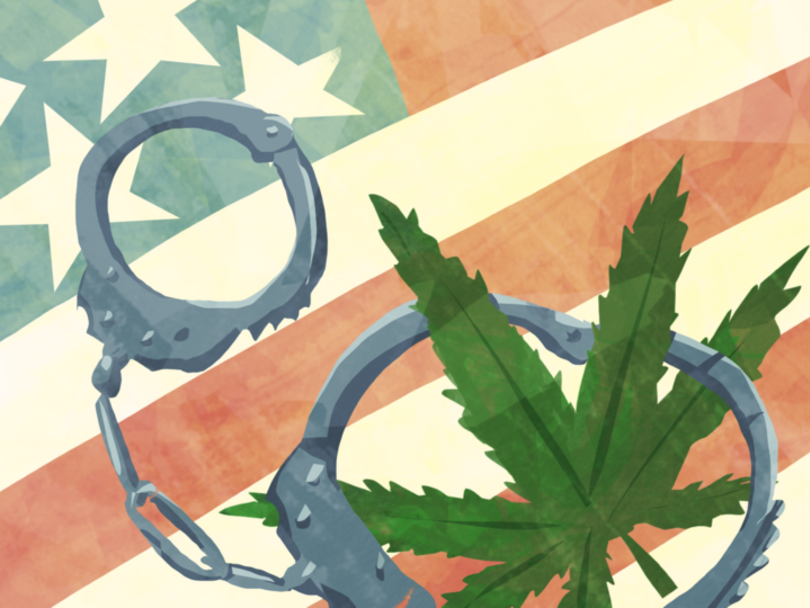Opinion: Legalization of cannabis isn’t enough to eradicate racist stigma

Cannabis legalization may seem like ample justice, but there’s more nuance to uncover when confronting racist drug policies in America. Our columnist says this should demand redistribution of wealth into affected communities. Flynn Ledoux | Illustration Editor
Get the latest Syracuse news delivered right to your inbox.
Subscribe to our newsletter here.
America has ignorantly normalized the word “marijuana” the same way we’ve normalized millions of Black and brown people behind bars: through fear, structural and institutional racism, and dangerous normalization. When we swapped the scientific term “cannabis” for the exotic-sounding “marijuana,” we weren’t renaming a plant — we were constructing a threat.
“Marijuana,” or the anglo-American construction of it, is as much of an American phenomena as mass incarceration is. Legalizing weed didn’t halt the lingering historical racial underpinnings of its linguistic popularization, proven by racially unproportionate detention and incarceration rates.
Now, when Black people are more likely to be arrested for weed possession in every single state in America, we’re begged to question the roots of weed’s racialized stigma. Those roots are far more innate to America than we realize, and more harmful than we care to admit.
Looking back on the history of cannabis, it’s clear this racist rhetoric is nothing new. By evaluating and adjusting the language surrounding weed, we can actively fight the stereotypes accompanying it and demand reform beyond legalization.
The term “marijuana,” verbatim, doesn’t exist in Spanish, to some people’s surprise. According to NPR, most news reports and medical journal articles throughout the 19th century used the plant’s scientific name, cannabis, and related to its medical usage or role as an industrial textile.
This leaves the origins of the term “marijuana” without proper criticism, making it a subtle enforcer of systemic racism.
In the early 1900s, anti‑immigrant politicians and their press allies consciously shifted from the clinical “cannabis” to the foreign-sounding “marijuana.” They did this under the guise of public health concerns, but their real aim was to spark xenophobia.
Major newspapers were complacent in acting as echo-chambers, as seen in the Los Angeles Times’s 1905 headline, “Delirium or Death: Terrible Effects Produced by Certain Plants and Weeds Grown in Mexico,” which constructed cannabis into a Mexican menace.
This headline is one of many, alongside the 1915 Ogden Standard headline “Is the Mexican Nation ‘Locoed’ by a Peculiar Weed,” a story claiming that reports of “sudden bursts of bravery” from Mexicans were linked to their weed use.
The Great Depression only exacerbated that scapegoating.
As the United States economy crashed in the 1930s, politicians needed an easy target, and immigrants were their bull’s-eye.
The influx of Mexican laborers — fleeing the upheaval of the 1910s Revolution — coincided with the rise of “suggestive” jazz music, and white Americans conflated the two. Under this narrative, cannabis, jazz, Mexicans and Black Americans all blended into a single “vice” that corrupted lower‑class bodies and minds.
“Marijuana” is as much of an Anglicization of crime as mass incarceration is true to America.Valeria Martinez-Gutierrez, Columnist
That racist narrative reached its apex under Harry Anslinger, the first commissioner of the Federal Bureau of Narcotics. Starting in 1930, Anslinger toured the country evangelizing prohibition. He testified before Congress, blaming jazz & swing’s “satanic rhythms” on Black, Hispanic and Filipino smokers.
“Reefer makes darkies think they’re as good as white men … the primary reason to outlaw marijuana is its effect on the degenerate races,” Anslinger claimed in a different statement.
This racially-charged political agenda didn’t only target Mexicans, Filipinos and Black Americans. In 1911, Henry J. Finger — of California’s State Board of Pharmacy — sent a private letter to Hamilton Wright, chief architect of U.S. narcotics policy, warning that “a large influx of Hindoos” had set off a “habit” for cannabis indica and risked “initiating our whites.”
Finger used his bureaucratic authority to amplify xenophobia, suggesting South Asian immigrants were another corrosive influence on white youth. No studies, no evidence – just bigotry dressed up as a public health concern.
By the time Anslinger’s propaganda machine completed its work, the war on weed was fully armed. Federal grants poured billions into local police departments under the banner of narcotics enforcement.
And when cocaine arrests declined in the 1990s, officers simply pivoted back to “marijuana” as reason for arrest. As criminologist Jeffrey Lynch noted on NPR in 2013, “institutions don’t like to shrink,” so drug arrests climbed even as overall crime fell.
Today, legalization feels like progress – but it’s mostly a rebrand. As of 2020, nearly 90% of cannabis-related arrests were still for possession, not trafficking. And according to the ACLU, Black people remain almost four times more likely than white people to be arrested for possession, even though both groups consume cannabis at similar rates. From 2010-18, 31 states saw racial disparities in cannabis-related arrests stay the same or worsen.
Calling the plant “cannabis” instead of “marijuana” won’t dismantle systems, but is still an active refusal to reproduce language built to criminalize Black and brown bodies.
It’s about confronting the racialized scaffolding of this country’s drug policy — how it was never about a substance, but control. Once we acknowledge that, we have to push further.
Legalization alone isn’t justice. A whopping $248 million in revenue from the state-licensed cannabis industry is predicted to be generated next fiscal year in New York state alone. If states are profiting off taxes on cannabis through state-licensed dispensaries, that revenue must be funneled directly back into the communities that were overpoliced, imprisoned and economically destabilized by decades of criminalization.
That means investing in housing, education, mental healthcare and legal services — not letting that money disappear into general funds or carceral systems. Renaming is just the beginning. Redistribution is the real challenge.
Valeria Martinez-Gutierrez is a junior majoring in Geography, Sociology and Environment, Sustainability and Policy. Her column appears bi-weekly. She can be reached at vmarti10@syr.edu.






